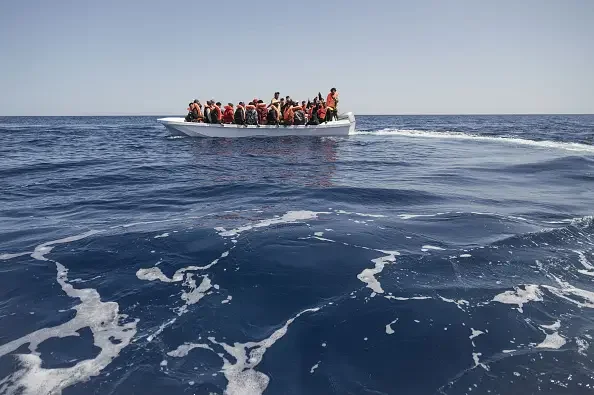Congolese city falls under M23 control, prompting thousands to seek safety across the border
Tensions in the eastern region of the Democratic Republic of Congo (DRC) reached a critical new level on Tuesday, January 28, when thousands of refugees, deserters, and stranded drivers crowded the border posts of neighboring Rwanda, hoping to escape the escalating violence. This exodus follows the capture of Goma, a strategic city near the border, by the insurgent group March 23 Movement (M23), whose actions have been destabilizing the region for years.

M23, once one of the most feared rebel groups in eastern Congo, resumed its offensive in 2021, intensifying attacks against the Congolese Army and expanding its control over key territories in North Kivu province. With the latest advance on Goma, the humanitarian crisis in the region reached a new peak, with thousands of civilians forced to leave their homes in search of refuge.
The M23 offensive began on the night of Monday, January 27, when explosions and gunfire echoed throughout Goma. Reports from residents indicated that the rebels quickly took military posts and strategic buildings, forcing the Congolese armed forces to retreat. Panic spread among the population, prompting thousands of families to flee their homes in haste.
The scene at the Congolese-Rwandan border was one of desperation and chaos. Throughout the night, long lines of people formed on the Congolese side of the crossing, waiting for permission to cross. Men, women, and children carried only what they could hold—mattresses, bags of clothes, cooking pots, and even small household appliances. Many left everything behind, knowing that staying could mean being caught in the crossfire.
Some refugees reported hours of waiting to cross the border, fearing both the advancing rebels and the possibility of being turned away by Rwanda. “We heard explosions very close, and the soldiers fled before the rebels even arrived. Then we knew we had to leave immediately,” said Pascal Mukeba, a Goma resident who escaped with his wife and three young children.
By Tuesday morning, Rwandan authorities finally opened the crossing, allowing the refugees to enter. Many crossed in tears, expressing gratitude amidst the fear and trauma of the previous night.
Those who made it to Gisenyi, the first Rwandan city after the border, were directed to makeshift reception centers. Entire families waited outdoors under the hot sun, sitting on the ground, awaiting registration by Rwandan authorities.
The capture of Goma marks a new chapter in the humanitarian crisis in eastern Congo, which has already been plagued by years of violence and instability due to the presence of dozens of armed groups. Since the beginning of 2024, over 400,000 people have been displaced by the ongoing conflict in the region, a number that is expected to continue rising.
Humanitarian organizations warn that the situation at the DRC-Rwanda border could become unsustainable if fighting continues and more people are forced to flee. The high flow of refugees is putting additional strain on resources in Rwanda, which already hosts over 114,000 refugees, 56% of whom are Congolese, according to the UN Refugee Agency (UNHCR).
The Congolese government accuses Rwanda of being behind the resurgence of M23, providing troops, weapons, and training to the rebels—an accusation that the Rwandan government repeatedly denies. However, reports from security experts suggest that there is concrete evidence of Rwandan involvement, further heightening tensions between the two countries.
Despite the growing diplomatic friction, Rwanda continues to accept refugees, albeit with a controlled reception policy. In Gisenyi, registration lines stretch for hundreds of meters, while authorities attempt to manage the flow of people.
Among the refugees, children are the most vulnerable. Many arrived visibly malnourished and weakened, having spent days fleeing the outskirts of Goma before reaching the border. Some mothers carried newborns tied to their backs or chests, while others tried to comfort terrified children frightened by the sounds of explosions.
“My three-year-old hasn’t slept since yesterday. He just cries and asks if the bad men will find us here too,” said Miriam Kavira, a mother of two who sought refuge in Rwanda with her family.
In addition to the civilian flight, an increasing number of soldiers from the Congolese armed forces (FARDC) have deserted and crossed into Rwanda in recent days. At least 102 soldiers surrendered on Monday, according to Rwandan regional ambassador Vincent Karega.
In a large hall in Gisenyi, dozens of soldiers sat on the floor, under the watch of the Rwanda Defence Forces. Some were still wearing FARDC uniforms, while others had already changed into civilian clothes. Many arrived wounded, receiving emergency treatment for cuts and battle injuries.
Karega assured that the soldiers would be treated as refugees, provided they handed over their weapons and were formally registered.
The desertion of so many soldiers raises alarming questions about the Congolese Army’s ability to withstand the M23 advance. With a history of logistical weakness and low morale, the FARDC struggles to contain the rebel advance, opening the way for a possible broader takeover of North Kivu province.
The impact of the conflict is not limited to the DRC and Rwanda. Instability in eastern Congo could destabilize the entire Great Lakes region, increasing tensions between neighboring countries and putting pressure on the international community to intervene.
Meanwhile, refugees continue to arrive in Rwanda, unsure of when—or if—they will be able to return home. Local authorities are working to provide basic assistance, but with each new day, the number of displaced people grows, presenting Rwanda with an increasingly greater humanitarian challenge.
The crisis in Goma is a brutal reminder of the fragility of peace in the region and the urgent need for a diplomatic solution before the conflict turns into a larger war.

